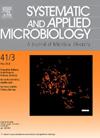多形Liberiplasma polymorphum gen. nov., sp. nov.,一种从陆相泥火山中分离出来的新型无细胞壁的自由生活厌氧菌。11月和自由等离子体
IF 4.2
2区 生物学
Q2 BIOTECHNOLOGY & APPLIED MICROBIOLOGY
引用次数: 0
摘要
从俄罗斯塔曼半岛陆相泥火山中分离到一株新的厌氧自由生活细菌(菌株C05PYGT)。细胞呈多形性,但主要由小的、无细胞壁的、不运动的球菌组成,直径为0.40 ~ 0.46 μm。生长温度范围为5 ~ 37℃(最适温度为30℃)。生长的pH范围为7.5 ~ 10.0,最适pH为8.0 ~ 9.0。它是一种化学有机异养菌,发酵单、双多糖和多糖(糊精、淀粉)、蛋白质底物和有机酸(乳酸和丙酮酸)。酵母提取物是生长所必需的。菌株C05PYGT具有降解外来DNA的能力。主要细胞脂肪酸为C16:0和i-C17:0;主要的二甲基缩醛为C14:0 DMA和i-C15:0 DMA。菌株C05PYGT的基因组大小为2.0 Mb, DNA G + C含量为33.0% (WGS)。基于120个标记基因的系统发育分析将菌株C05PYGT置于Mollicutes纲中与Acholeplasmatales相邻的一个单独的目,迄今为止被称为“Izemoplasmatales”,该目未包含具有有效发表名称的代表。我们建议将菌株C05PYGT归属于一个新属的新种,Liberiplasma polymorphum gen. nov., sp. nov.;型应变为C05PYGT (=VKM B-3767T = BIM B-2060T = UQM 41800T)。这个属被归入一个新的科,野浆科。11月在新目Liberiplasmatales目11月,Mollicutes纲。本文章由计算机程序翻译,如有差异,请以英文原文为准。
Liberiplasma polymorphum gen. nov., sp. nov., a novel cell-wall-less free-living anaerobe, isolated from a terrestrial mud volcano, and proposal of Liberiplasmataceae fam. nov. and Liberiplasmatales ord. nov
A novel anaerobic free-living bacterium (strain C05PYGT) was isolated from a terrestrial mud volcano (Taman Peninsula, Russia). Cells were pleomorphic but mainly consisted of small, cell wall-less, non-motile cocci, 0.40–0.46 μm in diameter. The temperature range for growth was 5–37 °C (optimum at 30 °C). The pH range for growth was 7.5–10.0, with an optimum at pH 8.0–9.0. It was a chemoorganoheterotroph, fermenting mono-, di- and polysaccharides (dextrin, starch), proteinaceous substrates and organic acids (lactate and pyruvate). Yeast extract was essential for growth. Strain C05PYGT possessed an ability to degrade extraneous DNA. Major cellular fatty acids were C16:0 and i-C17:0; major dimethyl acetals were C14:0 DMA and i-C15:0 DMA. The genome of strain C05PYGT had a size of 2.0 Mb with a DNA G + C content of 33.0 % (WGS). Phylogenetic analysis based on 120 marker genes placed strain C05PYGT in a separate order adjacent to the order Acholeplasmatales within the class Mollicutes, hitherto referred to as “Izemoplasmatales”, which contains no representatives with validly published names. We propose to assign strain C05PYGT to a novel species of a novel genus, Liberiplasma polymorphum gen. nov., sp. nov.; the type strain is C05PYGT (=VKM B-3767T = BIM B-2060T = UQM 41800T). This genus is placed in a novel family, Liberiplasmataceae fam. nov. within the novel order Liberiplasmatales ord. nov., class Mollicutes.
求助全文
通过发布文献求助,成功后即可免费获取论文全文。
去求助
来源期刊

Systematic and applied microbiology
生物-生物工程与应用微生物
CiteScore
7.50
自引率
5.90%
发文量
57
审稿时长
22 days
期刊介绍:
Systematic and Applied Microbiology deals with various aspects of microbial diversity and systematics of prokaryotes. It focuses on Bacteria and Archaea; eukaryotic microorganisms will only be considered in rare cases. The journal perceives a broad understanding of microbial diversity and encourages the submission of manuscripts from the following branches of microbiology:
 求助内容:
求助内容: 应助结果提醒方式:
应助结果提醒方式:


